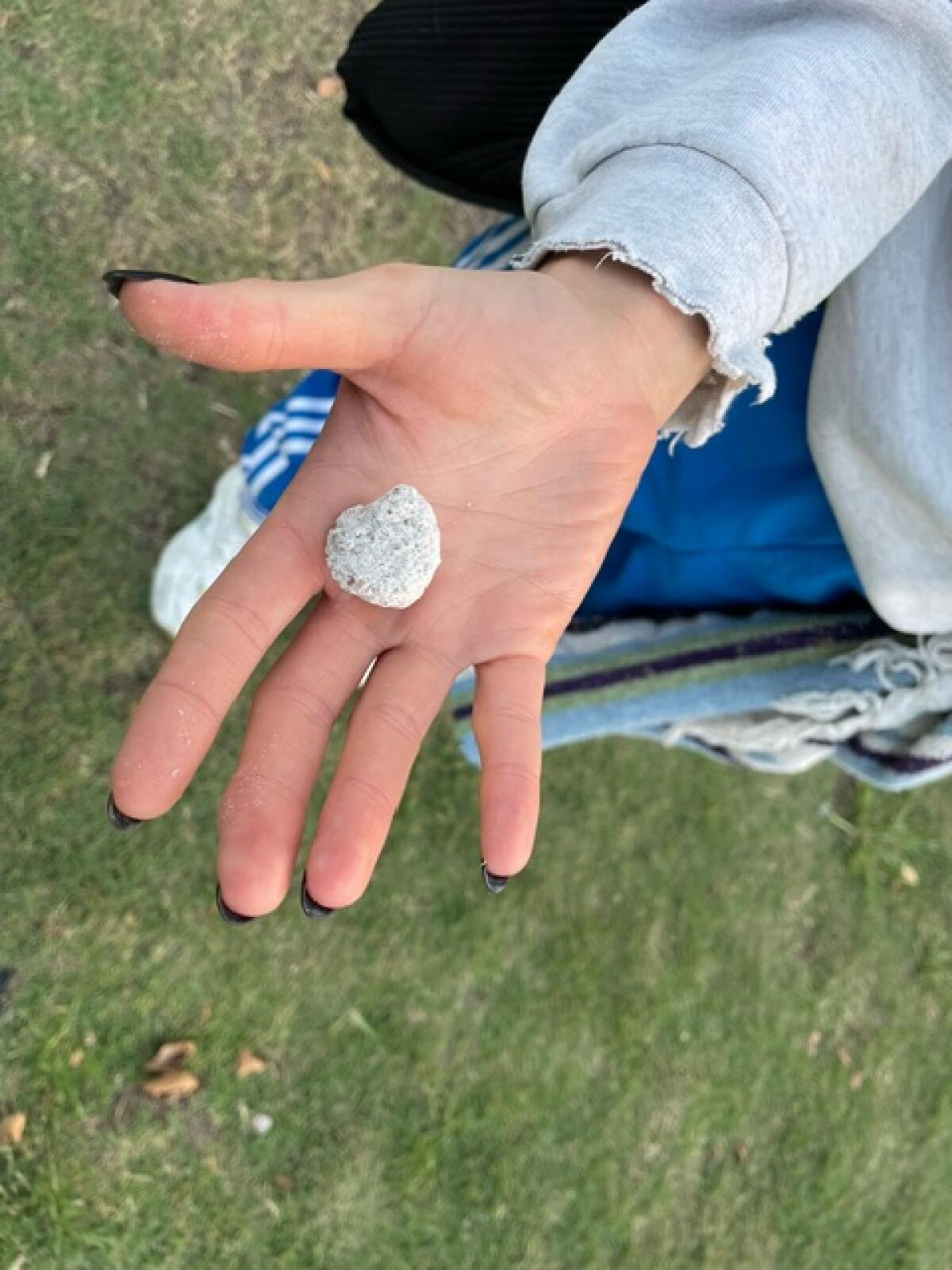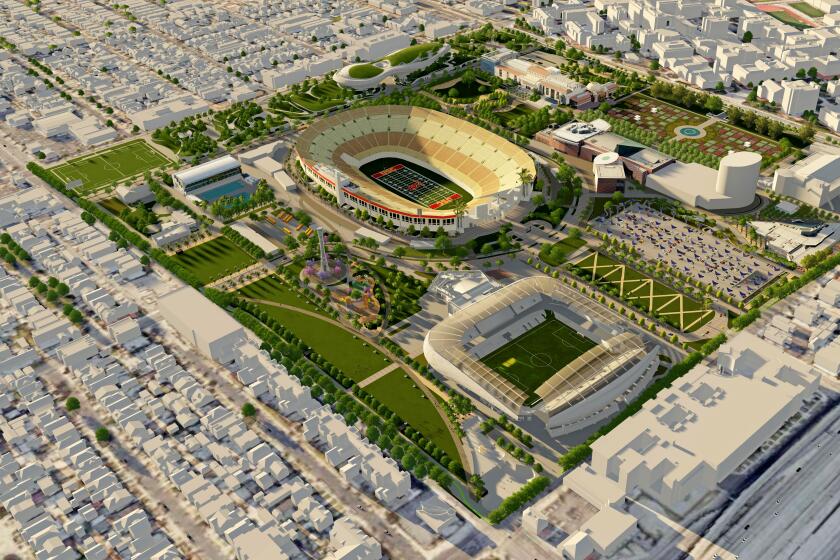Getty PST Art fireworks show caused injuries, so what went wrong? Artist Cai Guo-Qiang answers

- Share via
- Quarter-size rocks rained down on a crowd watching a fireworks display launching the Getty’s PST Art festival, prompting an inquiry by fire officials.
- The explosions were loud enough that local residents feared a bomb attack.
- In his first interview about the complaints, the artist explains what he thinks went wrong.
It wasn’t the experience many people had expected. The daytime fireworks show kicking off the Getty’s PST Art festival seemed to have suffered an explosive malfunction. Or had it?
Debris, including fireworks tubes and what looked like rocks the size of quarters, rained down on the crowd of 5,000 assembled at the Los Angeles Memorial Coliseum for the show, titled “We Are,” by Chinese artist Cai Guo-Qiang. At least two people reported injuries from the falling rocks, which turned out to be clay fireworks caps sent skyward during the detonation of 50,000 pyrotechnic devices. In photos sent to The Times by a bystander watching “We Are” from the lawn at the neighboring Natural History Museum of Los Angeles County, one person’s sweatshirt had burn holes purportedly created by the falling debris. The office of the state fire marshal is investigating the event.

According to people in attendance, including Times classical music critic Mark Swed, the fireworks were unexpectedly — some said excruciatingly — loud. Residents in the surrounding South L.A. neighborhood said they thought bombs were exploding, and the smoke that wafted into their streets unsettled them, forcing some to close windows and leading others to believe that they were in the midst of an emergency.
In the wake of the Sept. 15 event, commissioned by the Getty, many questions remained unanswered. Did anybody involved — the Getty, the L.A. Coliseum, the fire marshal, the pyrotechnics team hired to stage the display or the artist who designed it — anticipate the noise and debris? Why was nobody in the audience, or neighborhood, warned of the risk? And what exactly did go wrong?

For the first time since the event, Cai has spoken about what happened. In an email responding to questions from The Times, he said: “There were no malfunctions with the fireworks.”
The artist said the fireworks displayed as he had designed, but even he was surprised by the severity of the sound and the debris — adding that he was “deeply uneasy and apologetic.” He said winds that day may have been to blame, and that he relied on his pyrotechnics contractor to stage the show safely.
Cai contracted the Rialto-based company Pyro Spectaculars by Souza, which has operated for nearly 100 years and dubs itself “one of the largest and most respected fireworks display companies in the world.”
The artist used his own AI model, called cAI, to power the performance, which he had hoped would introduce AI into the “creative choreography of fireworks.” The result included an opening scene featuring 12 exploding zodiac signs, followed by air bursts set off among the seats of the stadium forming words coined by the AI model. Long plumes of color were fired off from the top of the Coliseum’s perimeter wall, and for the first time in 100 years, pyrotechnics erupted from the cauldron of the Olympic torch atop the stadium, representing “humanity’s theft of fire,” Cai said. One part of the show, he added, was his expression of a story from his childhood in which the god of thunder lashes out against bad children.

Pyro Spectaculars by Souza did not respond to The Times’ multiple requests for comment, but a behind-the-scenes video it posted on YouTube shows the six days it spent setting up the event, an effort that involved 70 technicians and a 30-person drone crew who prepared and placed 11,000 pyrotechnic devices in a 360-degree formation within the Coliseum’s seating and mounted 2,300 drones with fireworks.
The 50,000 fireworks exploded with organic, sustainable dyes — a hallmark of Cai’s practice. Promotional materials from the Getty called the event the first such display in U.S. history to feature a drone formation equipped with pyrotechnic devices.
“The fireworks company I hired to realize the show has executed hundreds of fireworks displays at this stadium and its surroundings and is highly experienced,” Cai said. “It worked closely with relevant agencies. My studio and I adhered to the fireworks company’s professional guidance and requirements at every stage of the process.”
Parking will move underground, creating six acres of green space where asphalt used to be. That’s just one change in a charge being led by Expo Park’s new 40-year-old general manager, Andrea Ambriz.
When asked about reports of injuries, including one person on a stretcher, the Getty confirmed that two people inside the Coliseum required first aid but declined to provide more details. A spokesperson said Getty Trust Chief Executive Katherine Fleming expressed her concern and offered assistance in person.
Regarding the noise, the Getty spokesperson said: “It was certainly loud. We regret that some neighbors and attendees were disturbed by the sound. The Coliseum followed its normal process for events held at the stadium and notified municipal partners.”
A spokesperson for the Coliseum wrote: “The Los Angeles Memorial Coliseum followed all event procedures in hosting this event and have no further comment.”
A representative for the Los Angeles Fire Department told The Times that Cal Fire’s Fire Engineering and Investigations unit in Hollywood, working under the state fire marshal, is conducting the investigation, per protocol for any “injury or malfunction involving fireworks.”

“PST meets PTSD,” quipped Swed, who said the noise was war-like and the explosions strong enough to make the ground shake. Other members of the audience noted the presence of children in the Coliseum and dog owners in the park trying to calm pets distressed by the explosions.
Those in attendance noted that it was a cool, windy day — a welcome respite a week after a heat wave that baked the city with temperatures soaring into the triple digits.
Cai speculated that “unexpected gusts of wind” sent the debris into the crowd, “since fireworks were launched 360 degrees around the audience,” he said. “Additionally, the stadium’s bowl-like structure might have amplified the sound.”
He added, “In hindsight, I realize I should have reminded the audience via broadcast about the potential for loud sounds.”
Complaints on social media raised the hypocrisy of a science- and environment-themed art festival creating so much air and noise pollution. Cai has used gunpowder in his art for years and said he has “long been involved in improving the environmental and safety aspects of fireworks, both from an artistic and technical perspective.”
A PST Art exhibition of Cai’s work, “Cai Guo-Qiang: A Material Odyssey,” is running at the USC Pacific Asia Museum in Pasadena. It explores Cai’s long history of working with gunpowder and pyrotechnics to create visually arresting — and often highly unpredictable — artwork.
Cai said that despite the unease his art might provoke, his aim remains “an infinitely fascinating experience that fills one with boundless admiration and emotion.”
More to Read
Sign up for This Evening's Big Stories
Catch up on the day with the 7 biggest L.A. Times stories in your inbox every weekday evening.
You may occasionally receive promotional content from the Los Angeles Times.











